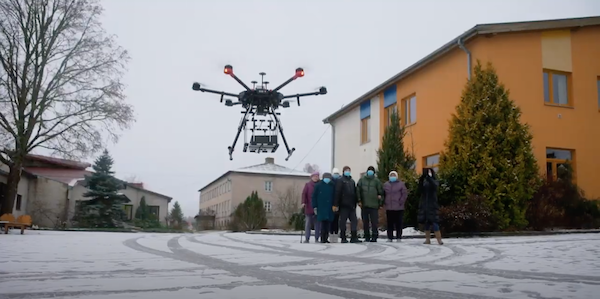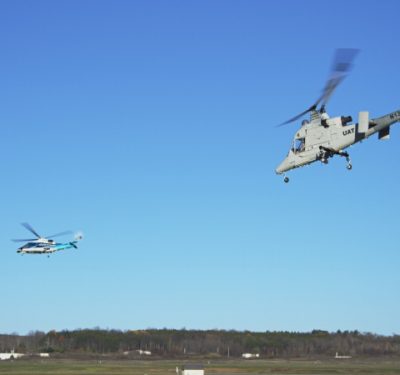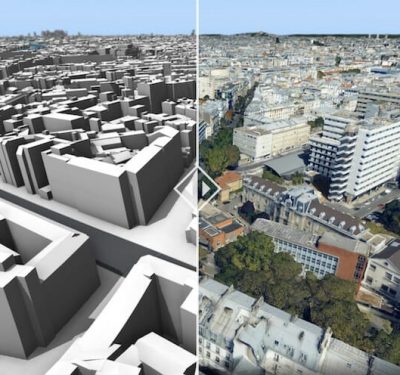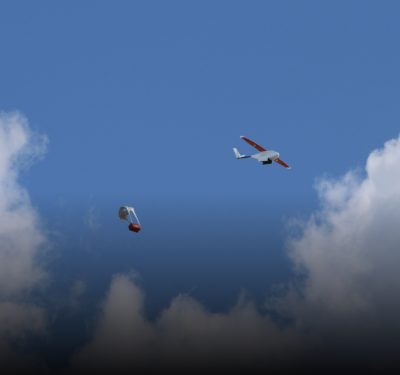In December, Latvia received a gift. More precisely, seniors welcomed the country’s first-ever drone gift delivery when a parcel was dispatched BVLOS (beyond visual line of sight) via a mobile network. Residents of various social care centers in the country received tablets from LMT—said to be Latvia’s leading mobile operator—outfitted with apps that allowed the elderly to communicate with their relatives, follow the news and learn new skills.

Residents of a social care center witnessing the first-ever remote drone delivery in Latvia.
“Using a UAV to deliver parcels is a great example of how technologies serve people,” said Ingmars Pukis, vice president of LMT, in a release. “LMT is actively working towards promoting safer drone flights BVLOS on mobile networks.”
This first use of BVLOS technology in Latvia to support the general public was a joint demonstration across three local companies.
LMT planned and coordinated with relevant authorities and organizations. The mobile operator provided connectivity for C2 linkage from the ground control station to the drone using its LTE network. Its remote ID device prototype identified and followed the drone during flight.
SPH Engineering, a UAS software developer and integration service provider, provided mission planning, the control software UgCS and technical support.
Representing a real-time user, DPD Latvia is part of DPDgroup, the largest parcel delivery network in Europe.
“Drone delivery is turning into a new applicable global trend,” said Alexey Dobrovolskiy, CTO of SPH Engineering in that same release. “We are proud to…support drone deliveries across Latvia.”
Local Delivery Development
LMT and SPH Engineering began collaborating in 2019, when LMT demonstrated its first BVLOS flight in Latvia with a C2 link via a cellular network. A cross-border flight demo followed in fall 2020, which in turn led to the recent parcel flight. “We wanted to connect the drone delivery demonstration with a future usage scenario,” Gints Jakovels, innovation lead (UAS/UTM Development and Solutions), told Inside Unmanned Systems, “so we got in touch with DPD Latvija.”
The cellular network was tested pre-flight for availability. And, of course, how the drone would carry the parcel needed to be worked out (a DJI M600 was used in this case, but the software can be adapted for other drones). “The SPH Engineering team came up with a custom-made 3D printed box type solution that looked more like a cage,” Jakovels added, “and it was nicely attached to the drone.”
Baltic Rules, Regulations, Challenges
“In Latvia, drone flights are normally only allowed within direct line of sight, due to safety concerns,” Jakovels reported. BVLOS permissions “can mainly be granted in research and testing cases, but “closing the airspace to other participants is a complex and time-consuming process.
“As there are no standard scenarios in place for actually any BVLOS flights, it’s always a challenge from a legislation perspective to get such flights approved,” Jakovels added. “So we are constantly talking with the authorities about processes that could be and must be approved to drive future usage of drone solutions.”
Operations over people fall under EU regulation, which requires flight application and completing a multistage SORA (Specific Operations Risk Assessment) process. Jakovels described the process as “cumbersome” while noting that getting flight permission in Estonia was much simpler. Estonia is known for fast internet and digital connections, and Jakovels felt that both Latvia and Estonia are ahead of Lithuania in drone development and usage because they have several companies and start-ups that manufacture drones and develop drone services.
UAS user interest from the B2B side is growing in Latvia, but investor caution exists around technical limitations and those legislative issues. Still, Jakovels concluded, “Latvia definitely strives to be at the forefront for different kinds of future UAS solutions, and at the moment it seems that we are on the right track.”






